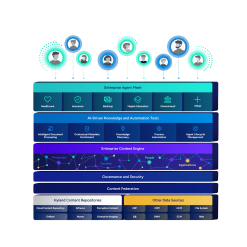French Ministry of Agriculture
Agency leverages Hyland's Nuxeo Platform to build and deploy custom content-centric solutions with an accelerated time to delivery.

Harness the power of a unified content, process and application intelligence platform to unlock the value of enterprise content.
Learn more
Automate your document-centric processes with AI-powered document capture, separation, classification, extraction and enrichment.
Learn about Hyland IDPIt's your unique digital evolution … but you don't have to face it alone. We understand the landscape of your industry and the unique needs of the people you serve.
 Overview of industries
Overview of industries
Countless teams and departments have transformed the way they work in accounting, HR, legal and more with Hyland solutions.
 Overview of departments
Overview of departments
We are committed to helping you maximize your technology investment so you can best serve your customers.
 Overview of services
Overview of services

Discover why Hyland is trusted by thousands of organizations worldwide.
Hear from our customers
Our exclusive partner programs combine our strengths with yours to create better experiences through content services.
Overview of partners
Join The Shift newsletter for the latest strategies and expert tips from industry leaders. Discover actionable steps to stay innovative.
Register now
Hyland connects your content and systems so you can forge stronger connections with the people who matter most.
Learn about HylandWith our modern, open and cloud-native platforms, you can build strong connections and keep evolving.
 Dig deeper
Dig deeper
Reading time minutes
Agency leverages Hyland's Nuxeo Platform to build and deploy custom content-centric solutions with an accelerated time to delivery.

The French Ministry of Agriculture made a choice to use Hyland's Nuxeo Platform for developing internal content-centric applications. The Ministry has deployed a strategy to limit the number of software components in order to optimize skills and infrastructure, and has invested in methodologies such as MAREVA, CMMi and ITIL.
The objective is to enable their teams to build and deploy custom solutions with an accelerated time to delivery.
Today, they have five development projects based on the Nuxeo Platform, ranging from document management to correspondence management to managing the flow and distribution of government memorandums.
Following is a profile of the two major projects in the portfolio: Memorandum management and correspondence management.
At the Ministry of Agriculture, communication passes through memorandums, which are distributed to the agencies within the Ministry. They can also appear in a journal that is published every Thursday on an intranet site for internal users, or in an official Ministry newsletter for the public.
There were some problems with the manual processes behind this distribution, such as:
The Memorandum Management application manages the publishing and distribution from a single source, eliminating duplication of content and administration. Nuxeo Platform serves as a content management back end, and Nuxeo WebEngine is the front end.
— Julie Lecomte, Project Manager, French Ministry of Agriculture
The application automates processes, from creation of the memorandums to generation of a cover page and the public process. There is also a subscription service for users, so they can automatically receive a weekly summary of published memorandums.
The creation of memorandums is guided by the application, with a form and metadata that must be filled out. Then there is a validation process with a timestamp. A single memorandum consists of the note itself and related documents, which are all compiled into a single PDF. The PDF is then validated, and a request to publish is issued.
Each memorandum has a permission type that indicates whether it is to be published internally, on the public site or limited to a specified group.
Every Thursday at noon, three automated processes are launched:
There is also a notion of archives, and it's possible to consult all weekly summaries online, either through navigation or advanced search mechanisms. All of the memoranda are also classified by theme.
The Memorandum Management application was built in six months. It introduced a set of automated mechanisms designed with Nuxeo Studio that improved the process of developing, validating and publishing. It also helped improve consultation through search and thematic browsing.
Finally, it has improved distribution through a subscription process and a system of automatic notifications developed with Nuxeo Studio, while centralizing the management of access rights, with many end-user profiles.
One of the manual processes at the French Ministry of Agriculture is the management of the back-and-forth exchanges of correspondence by fax, paper and email. They have tried in the past to manage correspondence with different software tools, but they were too complicated to use, and the users, who were secretaries at the Ministry, did not adopt them.
The goals of the new correspondence management application were:
The solution, built with the Nuxeo Platform, is pragmatic and user friendly. For incoming correspondence, it provides functionality to enter the mail item, assign it or redirect it, and classify it. Functionality for outgoing correspondence includes validation, a timestamp and classification.
Nuxeo Studio was used to customize and configure the application, so maintenance would be as easy as possible. Nuxeo Studio features were used for:
To build a better user experience, the number of clicks was reduced wherever possible. For example, a simple “Save and Create” button enables users to create multiple entries faster.
Building the application took fewer than 20 days, with two people on the team. Design work in Nuxeo Studio was done by a junior employee, and no development was necessary.
The application was initially rolled out in a single department and then deployed for the entire Ministry.